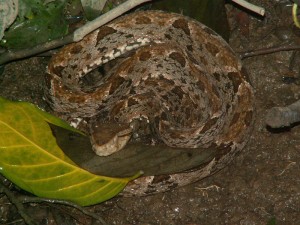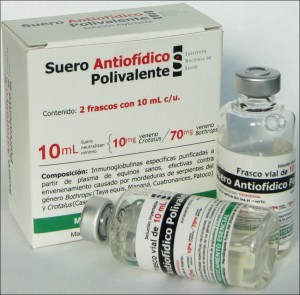If You’re Unfortunate Enough to get Bitten by a Snake, do it in Costa Rica

By Jack Ewing
“…and our dog Maggie has been bitten on the muzzle by a rattlesnake,” read the afterthought at the end of the email from my brother Rex.
Knowing that the only poisonous snakes in that part of Colorado are prairie rattlers, I figured that Maggie would survive. These small pit vipers are not nearly as dangerous as some of the other species, but can still kill. I wrote Rex to inquire about the bite. In the correspondence that ensued it came to light that Maggie had been vaccinated against rattlesnake bite, the vaccine cost about $25, and apparently gave her a partial immunity. Other than severe swelling in her face for about 24 hours, Maggie recovered just fine. It wasn’t necessary to take her to a veterinarian. Apparently there is no vaccine for people.

One further bit of information inspired me to delve into the subject of snakebites and write this article. In the 16 years since Rex and his wife LaVonne have lived in their present home, three of their neighbors have been snake-bitten, and the cost of treatment ranged from $70,000 to $100,000. I knew that snakebite serum in Costa Rica is very good and very inexpensive, and I wanted to know why it costs so much in Colorado. What I found is nothing short of amazing.
Instituto Clodomiro Picado
The late Dr. Clodomiro Picado Twight (1887 to 1944) was a medical doctor who worked at the San Juan de Dios hospital in San Jose. He is best known for his extensive research into venomous snakes in Costa Rica and the treatment of snakebite. The institute that honors this distinguished physician was founded in 1970. Its creation was a joint effort of the Ministry of Health and the University of Costa Rica.
I first visited the Instituto Clodomiro Picado in 1972. It was open to the public on Saturdays, and the demonstration of milking of the large venomous serpents was fascinating. One of the scientists explained how they produce the antidote for treatment of snakebite. Small doses of venom are injected into horses, and the dose is gradually increased as the horse’s immunity builds. Eventually the horse becomes totally immune to the bites of the most common pit vipers found in Costa Rica. Blood is drawn from the horses, and the cells separated from the serum in a centrifuge. The antibody laden serum is the base for the anti-venom, sometimes called antivenin. He explained that there was a tremendous demand for the serum especially in the rural areas where low income farm workers make their living working in fields and pastures frequented by poisonous snakes. It was the mission of the institute to produce enough high quality serum to treat anyone who needs it. We went away from the demonstration full of admiration and awe.
The Instituto Clodomiro Picado has grown and evolved into a prestigious institution that all Costa Ricans can be proud of. In the year 2014 the facility produced 90,000 vials of antivenin, about half of which was used in Costa Rica. Additionally their products are sold throughout Central and South America and even in Africa. Costa Rican hospitals treat an average of 600 snakebites annually, mostly terciopelo. In spite of the large number of bites there are only one or two deaths, testimony to the excellence of the antidote.

Most in demand is a product called Suero Antiofidico Polivalente. This is effective in the treatment of bites from most of the pit vipers of Central America. It is elaborated with the venom of the three most common pit vipers in Costa Rica: terciopelo (Bothrops asper), bushmaster (Lachesis stenophrys), and rattlesnake (Crotalus simus). Polivalent serum is available in liquid form with a shelf life of 3 years when refrigerated, and in a dry form that is mixed with sterile solution shortly before using. The dry form has a shelf life of 3 years without refrigeration. The institute manufactures a similar product for veterinary use, and another that is specific for coral snakes. They have even elaborated a serum that is effective in the treatment of the bites of some of Africa’s venomous serpents. This last product is exported mostly to Nigeria. The Polivalent Serum is sold in Costa Rica for $19 to $20 per vial.
A friend of mine was bitten by a terciopelo in 2002 and was treated with the Polivalent product, of which she received a total of 10 vials. She was hospitalized at the Max Terán Valls hospital in Quepos for three weeks and her total bill for everything amounted to $10,500. The cost of the antivenin was insignificant. She mentioned that the hospital was very proficient in administering the treatment, and that during the three weeks she was there four other patients were admitted with snakebites.
Snakebite Treatment in the United States
I was curious as to why the treatment of the rattlesnake bites suffered by my brother’s neighbors was so costly, so I did a little digging. To date the FDA has only approved one antidote for the treatment of snakebites in the US, a product called CroFab. It is produced by a British Company called BTG Plc which, according to their web site, was named as one of Forbes.com’s most innovative growth companies. CroFab is similar to Instituto Clodomiro Picado’s Polivalent Serum in that both are produced by immunizing mammals to the bites of several different snakes and elaborating the antidote from the antibody laden blood serum of those mammals. But there are some differences, the most notable being that BTG uses sheep rather than horses. The Instituto Clodomiro Picado has their serpentarium, horse farm, and laboratory all in one place where they produce their snakebite antidotes. According to an article in Bloomburg Business BTG has the venomous snakes in the US, the sheep in Australia, and the laboratory in England. That’s right. You didn’t read it wrong. They milk the venom from four different kinds of venomous snakes in Utah and ship it to Wales for processing. From there it is shipped to Australia where it is used to immunize sheep against snake bite. Blood serum from the sheep is then shipped back to Wales where CroFab is manufactured and shipped to hospitals in the United States. The list price is $2700 per vial, but the discount price to hospitals is about $2200 per vial.
CroFab is apparently a very good product as the ratio between snakebites and deaths is about the same in the US as in Costa Rica. Estimates vary, but one source tells us that in the US there are approximately 5000 bites per year and only 10 to 15 deaths. There may be some competition on the horizon as a Mexican firm called Rare Disease Therapeutics is producing a product derived from horse serum that sells in Mexico for about $100 per vial. This product will supposedly be available to US hospitals soon.
But there is more than just the cost of the antidote. Reported in the Charlotte Observer and Time Magazine was the story of Eric Ferguson’s snakebite treatment. After being bitten by a snake Mr. Ferguson reported to the emergency room of a hospital in North Carolina. The bite wasn’t too serious, and he needed only four vials of antidote. He was released after 18 hours. His bill was $89,277. He had been charged over $20,000 per vial for the antidote. Mr. Ferguson did his homework, found out how much the antidote costs, and demanded to know why he was charged so much for a product that cost the hospital much less. A hospital spokesperson explained that the difference in price was due to the cost of storing, preparing, and administering the antidote. Also the cost of dealing with Medicare, Medicaid, and Insurance Companies was mentioned. It is beginning to look like even if the Mexican product does become available in the US for $100 per vial it probably won’t affect the price to the patient significantly. Most of the costs are hospital charges and not directly related to the value of the antidote. Eric Ferguson received a very minor bite, but there are other more severe cases that require a great deal more serum. Eleven-year-old Benjamin Smith received a massive bite from an eastern diamondback rattlesnake and needed 80 vials of CroFab. His hospital bill was $1,600,000. With medical costs like that it’s no wonder the television show “Breaking Bad” is so popular in the United States.
Several promising new techniques are being researched, but a product for treatment in humans is still in the distant future. One possibility now under study by the Instituto Clodomiro Picado is the use of chickens rather than horses to produce the antibodies that are the basis of the antivenin. Antibodies from the chicken’s blood are passed on to the yolks of their eggs. From there they can be extracted for use in the manufacture of antidotes.
According to Chemistry World a number of researchers are investigating a peptide found in the blood of opossums. It has long been known that opossums are amazingly resistant to snakebite. The peptide responsible for the immunity can be produced inexpensively by genetically engineered bacteria. Though still a long way from the production of a usable product the peptide has been tested in laboratory mice with very encouraging results.
According the the World Health Organization 1.8 million snakebites occur annually world wide resulting in 94,000 deaths. Most of the deaths are people from third world countries who don’t have access to treatment. Please don’t become one of those statistics. When in snake country use adequate foot wear and watch where you step. But if you do have the misfortune to become one of the 1.8 million, I recommend that you do it in Costa Rica.
